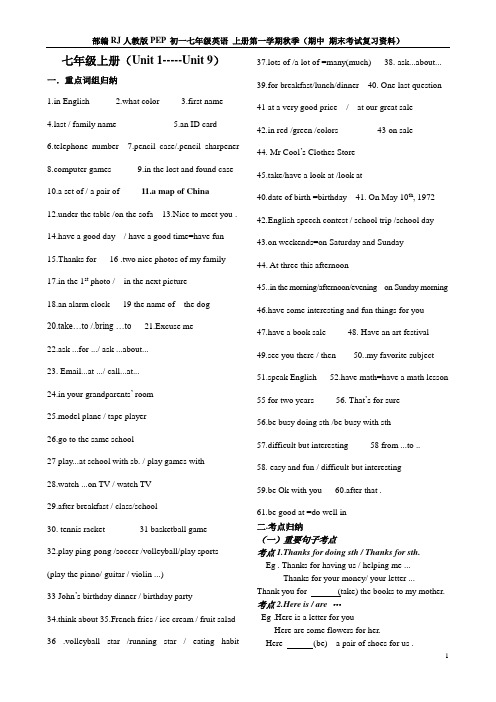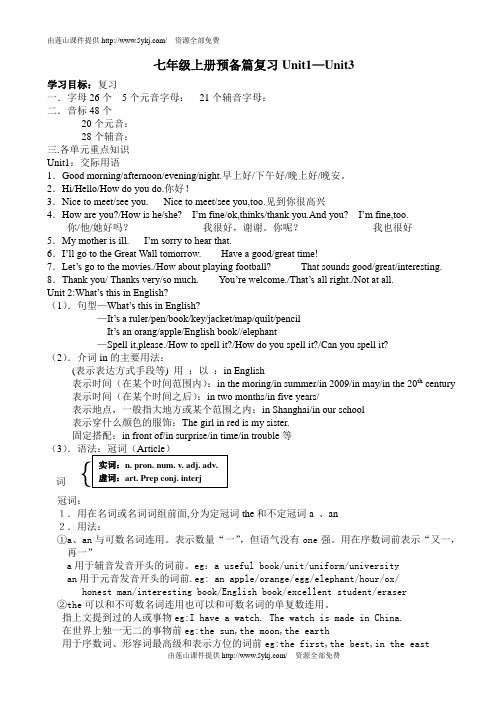新人教版七年级英语上册重点知识复习资料(全册)
部编RJ人教版PEP 初一七年级英语 上册第一学期秋季(期中 期末考试复习资料)课本复习考点归纳

七年级上册(Unit 1-----Unit 9)一.重点词组归纳1.in English2.what color3.first namest / family name5.an ID card6.telephone number7.pencil case/.pencil sharpenerputer games9.in the lost and found case 10.a set of / a pair of 11.a map of China12.under the table /on the sofa 13.Nice to meet you .14.have a good day / have a good time=have fun15.Thanks for 16 .two nice photos of my family17.in the 1st photo / in the next picture18.an alarm clock 19 the name of the dog20.take…to /.bring …to 21.Excuse me22.ask ...for .../ ask ...about...23. Email...at .../ call...at...24.in your grandparents’ room25.model plane / tape player26.go to the same school27 play...at school with sb. / play games with28.watch ...on TV / watch TV29.after breakfast / class/school30. tennis racket 31 basketball game32.play ping-pong /soccer /volleyball/play sports (play the piano/ guitar / violin ...)33 John’s birthday dinner / birthday party34.think about 35.French fries / ice cream / fruit salad 36 .volleyball star /running star / eating habit 37.lots of /a lot of =many(much) 38. ask...about...39.for breakfast/lunch/dinner 40. One last question41 at a very good price / at our great sale42.in red /green /colors 43 on sale44. Mr Cool’s Clothes Store45.take/have a look at /look at40.date of birth =birthday 41. On May 10th, 197242.English speech contest / school trip /school day43.on weekends=on Saturday and Sunday44. At three this afternoon45..in the morning/afternoon/evening on Sunday morning46.have some interesting and fun things for you47.have a book sale 48. Have an art festival 49.see you there / then 50..my favorite subject 51.speak English 52.have math=have a math lesson55 for two years 56. That’s for sure56.be busy doing sth /be busy with sth57.difficult but interesting 58 from ...to ..58. easy and fun / difficult but interesting59.be Ok with you 60.after that .61.be good at =do well in二.考点归纳(一)重要句子考点考点1.Thanks for doing sth / Thanks for sth.Eg . Thanks for having us / helping me ...Thanks for your money/ your letter ...Thank you for (take) the books to my mother. 考点2.Here is / are …Eg .Here is a letter for youHere are some flowers for her.Here (be) a pair of shoes for us .考点3.Let’s ...1) let’s 后接动词原形,let’s not 后接动词原形2) let ‘s ...引导的句子,对方应怎样表达个人的看法.赞成时用:that’s a good idea / that sounds great . Eg: Let’s (play ) basketball.Let’s (not, go ) home now . ----Let’s go to the movies this afternoon .-----That (sound) good .考点4.购物的句型1)Can I help you ? = What can I do for you ?2)I’ll take it/them = I’ll buy it /them3)How m uch +be +sth ? = What’s the price of sth? Eg: What is the price of the white watch ?(同义句)the white watch?考点5.think 用法Sb +think +主语+谓语注: 否定前移Eg: I English fun .我认为英语很有趣。
初中英语人教版七年级上册全册重点单词词汇扩展汇总(基础必考内容)

七年级英语上册重点单词词汇扩展Starter 1~Unit 41.good(adj.) →well(adv.)2.see(v.)→ saw(过去式)→seen(过去分词)3.can →could (过去式)4.say(v.)→said (过去式)→ said (过去分词)5.China(n.) →Chinese(adj.)6.family(n.)→ families (复数)7.dictionary(n.)→dictionaries (复数)8.meet(v.) → met(过去式/过去分词)9.I(pron.)→me( 宾格)→my(形容词性物主代词)→mine(名词性物主代词)→ myself(反身代词)10. this(pron.)→these(复数)11.that(pron.)→those(复数)13.watch(n.)→watches(复数)14.library(n.)→ libraries(复数)15.lose(v.)→lost(过去式)→lost(过去分词)e(v.)→came(过去式)→come(过去分词)17.think(v.)→ thought(过去式/过去分词)18.know(v.)→knew(过去式)→known(过去分词)19.thank(v.) →thankful(adj.)20.one(num.)→ first(序数词)→once(adv. 一次)21.two(num.)→second(序数词)→twice(adv. 两次,两倍)22.three(num. ) →third(序数词)23.nine(num.)→ninth(序数词)Unit 5~Unit 91.do(v.) →does(三单形式)→did (过去式)→done(过去分词)2.go(v.)→ goes(三单形式)→went(过去式)→gone(过去分词)3.get(v.)→ got(过去式/过去分词)te(adj.)→later(adv.)后来→lately(adv.) 最近,近来5.interesting(adj.)interest(n./v.)→interesting(adj.) 感兴趣的6.bore(v.)→boring(adj.) 没趣的→bored(adj.) 厌倦的7.fun(n./adj.)→funny(adj.)8.relax (v.)→relaxing (adj.) 令人轻松的→relaxed(adj.) 感到轻松的9.easy(adj.)→ easily( adv.)10.tomato(n.)→tomatoes(复数)11. have(v.)→has(三单形式)11.eat(v.)→ate(过去式)→eaten(过去分词)12.health (n.)→healthy(adj.)13.real(adj.)→really(adv.)14.take(v.)→took(过去式)→taken(过去分词)15.buy(v.)→ bought(过去式/过去分词)16.sell(v.)→sale(n.)17.tewlve(num.)→ twelfth(序数词)18.twenty(num.)→twentieth(序数词)19.happy(adj.)→ happily(adv.)→happiness(n.)20.music(n.) →musical (adj.)→musician(n.)音乐家21.history(n.)→ historical(adj.)22.free(adj.)→freedom(n.)e (n. /v.) →useful(adj.)24.love(n./v.)→ lovely(adj.)25.play(v.)→player(n)。
七年级上册英语同步人教版

七年级上册英语同步人教版一、单词部分。
1. 重点单词汇总。
- 名词。
- pen:钢笔,复数形式为pens。
例如:I have a pen.(我有一支钢笔。
)- pencil:铅笔,复数是pencils。
如:My pencil is blue.(我的铅笔是蓝色的。
)- book:书,复数为books。
She has many books.(她有很多书。
)- ruler:尺子,复数rulers。
The ruler is long.(这把尺子很长。
)- 代词。
- I:我,主格形式,作主语。
例如:I am a student.(我是一名学生。
)- you:你,你们,主格或宾格。
You are my friend.(你是我的朋友。
)/I like you.(我喜欢你。
)- he:他,主格。
He is my brother.(他是我的兄弟。
)- she:她,主格。
She is a teacher.(她是一名教师。
)- it:它,主格或宾格。
It is a cat.(它是一只猫。
)/I like it.(我喜欢它。
)- 形容词。
- good:好的。
This is a good book.(这是一本好书。
)2. 单词记忆方法。
- 联想法。
- 例如记忆“pencil”,可以联想“pen”(钢笔)和“cil”,想象一支钢笔旁边有一支铅笔。
- 制作单词卡片。
- 在卡片的一面写单词,另一面写单词的词性、词义和例句。
随时拿出来复习。
二、语法部分。
1. be动词的用法。
- be动词有am/is/are三种形式。
- am用于第一人称单数I后面,如:I am twelve years old.(我12岁了。
)- is用于第三人称单数(he/she/it)后面,例如:He is a boy.(他是一个男孩。
),She is at home.(她在家。
),It is a dog.(它是一只狗。
)- are用于第二人称(you)单复数和第一、三人称复数(we/they)后面。
人教版七年级英语上册英语重点、难点知识总结演示教学

人教版七年级英语上册英语重点、难点知识总结演示教学七年级上册英语重点、难点知识总结:(Starter)Unit 1.1. Good morning / afternoon / evening. 早上好/ 下午好 / 晚上好。
2. How are you! 你好吗? / How is your mother? 你的妈妈好吗?I’m fine / OK, thanks. 我很好,谢谢!/ She is fine. 她身体好。
And you ? 你呢?(你好吗?)(Starter)Unit 2.1. What’s this in English? 这个用英语怎么说?What’s this? 这个是什么?It’s a map / an orange. 它是一张地图 / 它是一个桔子。
2. Spell it, please. 请拼写它。
How do you spell it? 你怎样拼写它?(Starter)Unit 3.1. What color is it? 它是什么颜色? What color is your pen? 你的钢笔是什么颜色?2. It’s red / blue / black and white. 它是红色 / 蓝色 / 黑白色。
Unit 1.1. What’s your name? 你叫什么名字?What’s her / his name? 她 / 他叫什么名字?2. What’s your first name你的名是什么?What’s your last / family name?你姓什么?(last name = family name)3. I’m Mary. = My name is Mary. 我叫玛丽。
She is Mary. = Her name is Mary. 她叫玛丽。
4. Nice to meet you! 见到你真高兴。
Nice to meet you too. 见到你也很高兴。
人教版新目标 英语七年级上册 预备单元 总复习归纳(2013版)

七年级上册预备篇复习Unit1—Unit3学习目标:复习一.字母26个5个元音字母:21个辅音字母:二.音标48个20个元音:28个辅音:三.各单元重点知识Unit1:交际用语1.Good morning/afternoon/evening/night.早上好/下午好/晚上好/晚安。
2.Hi/Hello/How do you do.你好!3.Nice to meet/see you. Nice to meet/see you,too.见到你很高兴4.How are you?/How is he/she? I’m fine/ok,thinks/thank you.And you? I’m fine,too.你/他/她好吗?我很好,谢谢。
你呢?我也很好5.My mother is ill. I’m sorry to hear that.6.I’ll go to the Great Wall tomorrow. Have a good/great time!7.Let’s go to the movies./How about pl aying football? That sounds good/great/interesting. 8.Thank you/ Thanks very/so much. You’re welcome./That’s all right./Not at all.Unit 2:What’s this in English?(1).句型—What’s this in English?—It’s a ruler/pen/book/key/jacket/map/quilt/pe ncilIt’s an orang/apple/English book//elephant—Spell it,please./How to spell it?/How do you spell it?/Can you spell it?(2).介词in的主要用法:(表示表达方式手段等) 用;以:in English表示时间(在某个时间范围内):in the moring/in summer/in 2009/in may/in the 20th century 表示时间(在某个时间之后):in two months/in five years/表示地点,一般指大地方或某个范围之内:in Shanghai/in our school表示穿什么颜色的服饰:The girl in red is my sister.固定搭配:in front of/in surprise/in time/in trouble等(3)词冠词:1.用在名词或名词词组前面,分为定冠词the和不定冠词a、an2.用法:①a、an与可数名词连用。
Unit7 How much are these socks?【知识复习】七年级英语上册(人教版)

14.price n. 价格 price作名词, 常用结构如下: 1) at... prices/at a(n)... price “以……的价格”。 这家超市的物品价格很低。 The supermarket sells things at low prices. 他们以优惠的价格出售蔬菜。
They sell the vegetables at a good price.
How much are these socks?
They’re two dollars.
How much are those black trousers? They’re nine dollars.
How much are these yellow shorts? They’re nine dollars.
以跟名词、代词或动词不定式作宾语。其否定形式在
need前加don't或doesn't。
你需要水果吗? Do you need any fruit? 你今天不需要去上学。 You don't need to go to school today.
6.这个怎么样? How about this one?
sock作名词时,常以复数形式出现。表示“一双短袜”
用a pair of socks。与socks一样,常成对出现的名词还有
shorts, trousers, shoes.
2.这件T恤衫多少钱? 7美元。 —How much is this T-shirt? —It's seven dollars.
顾客询问价格:
How much is…?/How much are…? ······多少钱?
顾客选购时的用语: Can I try it/them on? 我可以试一试吗?
人教版初一英语七年级全册(上下册)重点短语和句型

人教版初一英语七年级全册(上下册)重点短语和句型人教版初一英语七年级全册(上下册)重点短语和句型人教七年级(上册)Starter Units 1-31.早上好!Good morning!2.下午好!Good afternoon!3.晚上好!Good evening!4.——你好吗?—How are you?我很好,谢谢。
/我还不错。
—I'm fine。
thanks。
/ I'm OK.5.——这个/那个用英语怎么说?—What's this / that in English?是……—It's a / an。
6.请拼写它。
Spell it。
please.7.——它是什么颜色的?—What color is it? 它是……色的。
—It's。
Unit 1n A1.我是……I'm。
2.你是……吗?Are you。
3.他/她是……He / She is。
4.——见到你很高兴。
—Nice to meet you.见到你我也很高兴。
—Nice to meet you。
too.5.——你/他/她叫什么名字?—What's your / his / her name?我/他/她叫……—My / His / Her name is。
n B1.名字first name2.姓last name3.在中国in China4.学生卡ID card5.这是你的号码吗?Is this your number?6.——你的电话号码是多少?—What's your telephone / phone number?是……—It's。
Unit 2n A1.家庭照片family photos2.这是/那是/这些是/那些是……This is / That is / These are / Those are。
3.她/他是谁?Who's she / he?4.他们是谁?Who are they?5.祝你过得愉快!Have a good day!6.我知道了。
人教版七年级上册英语知识点复习:第四单元

人教版七年级上册英语知识点复习:第四单元知识点对朋友们的学习非常重要,大家一定要认真掌握,为大家整理了人教版七年级上册英语知识点复习:第四单元,让我们一起学习,一起进步吧! 一.重点词组 1e of 2 .in the room 3. in the bookcase 4. on the chair 5.under the table 6. I don’t know 7. behind 在……后面 二. 重点句型. 1.Where’s the +东西? -----It’s + on in under + 介词短语 2.Where are your his her + 东西? --- They’re on in under +介词短语 三.知识点 1.介词:是用以放在名词或代词之前,表明该名词与其它词之间某种关系的一类词。
(不能单独使用,需与某一名词或代词等搭配成介宾短语)(on in under)eg: on the bed 2. 定冠词the 的用法: a. 常用在特指的单复数名词前,指某人,某物,某些人或某些物. eg: The students are boys. b . 用于双方都知道的人或物.eg: The girl is my friend. c. 上文提到的人或物,下文再次提到. eg: I have a pen. The pen is red. d. play 后跟球类名词是,不用the. 乐器前一定要用the. ( play basketball play the drums ) 3.. Here is my room. ( here is = this is ) 4.. have has : 表示“拥有” “占有”. eg: I have a computer.。
- 1、下载文档前请自行甄别文档内容的完整性,平台不提供额外的编辑、内容补充、找答案等附加服务。
- 2、"仅部分预览"的文档,不可在线预览部分如存在完整性等问题,可反馈申请退款(可完整预览的文档不适用该条件!)。
- 3、如文档侵犯您的权益,请联系客服反馈,我们会尽快为您处理(人工客服工作时间:9:00-18:30)。
新人教版七年级英语上册重点知识复习资料(全册)Starter Unit s 1-31.Good morning/afternoon/evening. 早上(上午)/下午/晚上好。
答语相同。
在熟人或家人之间可省略good。
熟人之间的问候可加上称呼语,称呼语放在问候语之后且用逗号隔开。
如:Good morning , class!同学们,早上好!△Good night!晚安(晚间告别用语)2. A: How are you? 你(身体)好吗?B: (I’m) fine/Very well/I’m OK, Thank you./thanks.How are you? / And you?我很好,谢谢。
你呢?A: (I’m)fine/OK, too.我也很好。
4. thanks = thank you 谢谢1.What’s this/that in English? 这/那用英语怎么说?It’s a/an + 单数物品(△不说This/That is...)What’s this in English? 这用英语怎么说?It’s a jacket. 夹克衫What’s that in English?那用英语怎么说?It’s an orange. 橘子。
in + 语言:用某种语言in Chinese/English/Japanese用汉/英/日语5. a 和an是不定冠词,只用在可数名词单数前面,表示“一”。
a用在以辅音音素开头的单词前;an用在以元音音素开头的单词前。
这里的元音音素和辅音音素是指读音,而不是指字母。
如:a pen /pen/ 一支钢笔(/p/为辅音音素)an orange /’ ɒrindʒ / 一个桔子(/ɒ /为元音音素)an egg / an apple / an orange / an eraser / an answer / an ID card /an e-mail / an hour/an old man / an interesting book / an exciting sport an art lesson6. Spell it, please. = Please spell it. 请拼读它。
K – E - Y.Spell “pen”, please. = Please spell pen. 请拼读“pen”。
P – E - N.注:please置于句末时,前面要加逗号。
7. What’s this/that? 这/那是什么?It’s V. 这是V。
V是字母,前面不必加冠词,但表示某一类东西,则在其单数名词前加a或an。
1) What’s this/that? 这/那是什么?2) What’s this/that? 这/那是什么?It’s a ruler. (这/那是)直尺。
It’s an apple. (这/那是)苹果。
8. 问颜色:What color1) What color is + 单数名词?2) What color are + 复数名词?It’s /It is + 颜色. They’re/They are + 颜色.如1) What color is the key?(这把)钥匙是什么颜色的?It’s (It is)yellow. (它是)黄色的。
2) What color are the keys? 这些钥匙是什么颜色的?They’re (They are) red.. (它们)是红色的。
3)It’s black and white. 它是黑白色的。
9. The key is yellow. 钥匙是黄色的。
The是定冠词,表示“这(个),那(个),这些,那些” ,在元音音素前读/ ði: /,在辅音音素前读. 定冠词the的用法:(1)特指某(些)人或某(些)物:The ruler is on the desk.(2)复述上文提到的人或物:He has a sweater. The sweater is new.(3)谈话双方都知道的人或物:The boys aren’t at school.(4)在序数词前:John’s birthday is February the second.(5)用于固定词组中:in the morning / afternoon / evening10.字母教学资料1)英语中共有26个字母。
其中的Aa,Ee,Ii,Oo,Uu 5个字母被称为元音字母。
这五个元音字母是构成英语成千上万单词的核心,除了一些缩略词之外,其它任何一个英语单词,通常都应包含一个或多个元音字母。
26个字母中的其它21个字母被称为辅音字母。
大写字母的用法1)英语句子开头的第一个字母必须大写。
2)I(我),OK在句中任何位置都大写。
3)人名、地名、国名、某国人或某种语言等专有名词的第一个字母必须大写。
4)表示称呼的名词的第一个字母通常要大写。
Uncle Wang王叔叔5)表示月份、星期、重要节日的名词的第一个字母必须大写。
6)某些缩略词的第一个字母都必须大写。
7)电影名、书名、报刊、文章的标题等中的每个实词(如:名词、动词、形容词、副词、数词)的第一个字母一般大写。
English Weekly《英语周报》Titanic《泰坦尼克号》11.英语句子的书写句子开头的第一个单词的第一个字母要大写,单词与单词之间要有适当的距离,一般为放入一个字母的空隙,句末要有标点符号,英语的句号是个实心圆点,而不是汉语中的小圆圈。
12.语音:复习教材75页84页要求能认读48个音素,能分清元音辅音,能拼读单词,能按读音记忆单词拼写。
掌握5个元音字母在重读开闭音节中的发音,掌握常见元音字母组合,辅音字母组合的发音。
如:13.词类参看教材P8514.Unit 1 My name’s Gina.1. 询问姓名1)What’s your name? 你叫什么名字? Alan艾伦/ My name’s Alan我的名字叫艾伦/ I’m Alan我叫艾伦What’s = What is name’s = name is I’m = I am2)What’s his name? 他叫什么名字?H is name’s Eric 他的名字叫埃里克。
/ He’s Eric . 他叫埃里克( He’s = He is )3)What’s her name?她叫什么名字?Her name’s Mary. 她的名字叫玛丽。
/ She’s Mary. 她叫玛丽。
( She’s = She is ) 2. Nice to meet you.见到你很高兴。
(初次见面用语。
)回答Nice to meet you. 或Nice to meetyou, too.3. How do you do? 你好!回答:How do you do? 你好!4. Mr ,Mrs ,Miss 和MsMr ['mistə(r)] 先生Miss [mis] 小姐,女士;(年轻未婚女子)Mrs ['misiz] 太太;夫人(用于已婚妇女姓名前)Ms. [miz] 女士5. Is he Jack? 他是杰克吗?Yes, he is. 是的,他是。
No, he isn’t. His name’s Mike. 不,他不是。
他的名字叫迈克。
6. Are you Helen? 你是海伦吗?Yes, I am.是的,我是。
/ No, I’m not. I’m Gina. 不,我不是。
我是吉娜。
7.英美人的姓名与中国人的姓名顺序相反,名在前,姓在后。
如Jim Green, 名是Jim,姓是Green。
△名字:first name(第一个名字)或given name 姓氏:last name(最后的名字)或family name(家族的名字)全名:full name8. 问电话号码:What’s your/his/her telephone number?It’s + 号码.10、Be的英法我(I)用am, 你(you)用are,is跟着他(he),她(she),它(it)。
单数名词用is,复数名词全用are。
变否定,更容易,be后not加上去。
变疑问,往前提,句末问号莫丢弃。
还有一条须注意,句首大写莫忘记。
针对练习1) I 14, how old you?我14岁,你多大了?2) He/She is a student.他/她是个学生。
What color it?3) The key yellow.钥匙是黄色的。
4)He and I students.他和我都是学生。
本块习题1、name is (缩略式)_______ boy (对应词)_______last name (同义词)_______ telephone number (同义词)_______my (主格人称代词)_______ you (形容词性物主代词)_______2.根据括号中的答案,用完整句子回答问题。
1.What’s your name ? ( Mary ) _______________________2.What’s his name ? ( Jim ) _______________________3.What’s his last name ( Green )?_______________________4.What’s her phone number( 92931 ) ?_______________________Unit 2This is my sister.1. parent: father or mother 父亲或母亲parents: father and mother父母(双)亲2. 介绍他人1) This / That is...这/那位是......2)These / Those are...这/那些是......This is my friend Jane.这(位)是我的朋友简That is my grandfather. 那(位)是我的祖父。
These are my brothers. 这些是我的兄弟。
Those are my parents. 那些是我的父母。
3. 指示代词this / these这/这些。
一般用来指时间或空间上较近的事物。
that / those那/那些。
一般用来指时间或空间上较远的事物。
4. This is my friend. 复数These are my friends.That is my brother. 复数Those are my brothers.相关练习:把句子中单数词变成复数词。
1、This is my friend . ______ ______my2、That is his parent . ______ ______his ______3、She is her cousin . ______ ______her ______4、He is my son . ______ ______ my ______5、It is my watch . ______ ______ my ______5. Who’s she? 她是谁?She’s my sister. 她是我妹妹。
